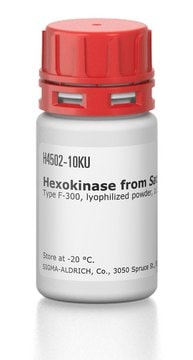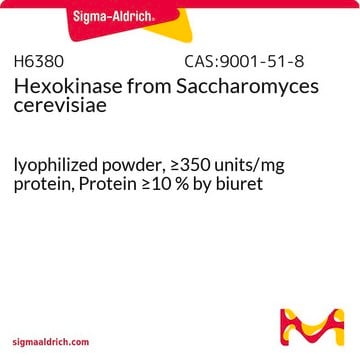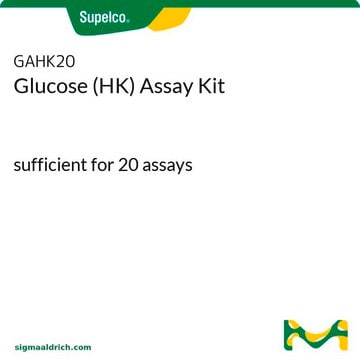H5000
Hexokinase from Saccharomyces cerevisiae
Type III, lyophilized powder, ≥25 units/mg protein (biuret)
Synonym(s):
ATP:D-Hexose-6-phosphotransferase, Hexokinase from yeast
Sign Into View Organizational & Contract Pricing
All Photos(1)
About This Item
Recommended Products
type
Type III
form
lyophilized powder
specific activity
≥25 units/mg protein (biuret)
mol wt
dimer 110 kDa
foreign activity
glucose-6-phosphate dehydrogenase and phosphoglucose isomerase ≤10%
storage temp.
−20°C
Gene Information
bakers yeast ... HXK1(850614) , HXK2(852639)
Looking for similar products? Visit Product Comparison Guide
Biochem/physiol Actions
Catalyzes the phosphorylation of D-hexose sugars at the C6 position utilizing ATP as a phosphate source.
The rate of phosphorylation varies with different hexoses (pH 7.5, 30 °C).
D-fructose KM: 0.33 mM
D-glucose KM: 0.12 mM
D-mannose KM: 0.05 mM
Yeast hexokinase exists as two similar isoforms, PI and PII (A and B), with isoelectric points of 5.25 and 4, respectively.
Molecular Weight: ~ 54 kDa (monomer)
~110 kDa (dimer)
Optimal pH: 7.5 to 9.0
Extinction Coefficient: E1% = 8.85 (PI) and 9.47 (PII) at 280 nm
Activators: Hexokinase requires Mg2+ ions (KM = 2.6 mM) for activity. Hexokinase is activated by catecholamines and related compounds.
Inhibitors: sorbose-1-phosphate, polyphosphates, 6-deoxy-6-fluoroglucose, 2-C-hydroxy-methylglucose, xylose, lyxose, and thiol reactive compounds (Hg2+ and 4-chloromercuribenzoate)
The rate of phosphorylation varies with different hexoses (pH 7.5, 30 °C).
D-fructose KM: 0.33 mM
D-glucose KM: 0.12 mM
D-mannose KM: 0.05 mM
Yeast hexokinase exists as two similar isoforms, PI and PII (A and B), with isoelectric points of 5.25 and 4, respectively.
Molecular Weight: ~ 54 kDa (monomer)
~110 kDa (dimer)
Optimal pH: 7.5 to 9.0
Extinction Coefficient: E1% = 8.85 (PI) and 9.47 (PII) at 280 nm
Activators: Hexokinase requires Mg2+ ions (KM = 2.6 mM) for activity. Hexokinase is activated by catecholamines and related compounds.
Inhibitors: sorbose-1-phosphate, polyphosphates, 6-deoxy-6-fluoroglucose, 2-C-hydroxy-methylglucose, xylose, lyxose, and thiol reactive compounds (Hg2+ and 4-chloromercuribenzoate)
Unit Definition
One unit will phosphorylate 1.0 μmole of D-glucose per min at pH 7.6 at 25 °C, unless otherwise indicated below.
Physical form
Lyophilized powder containing approx. 15% sodium citrate
Storage Class Code
11 - Combustible Solids
WGK
WGK 3
Flash Point(F)
Not applicable
Flash Point(C)
Not applicable
Personal Protective Equipment
dust mask type N95 (US), Eyeshields, Gloves
Choose from one of the most recent versions:
Already Own This Product?
Find documentation for the products that you have recently purchased in the Document Library.
Customers Also Viewed
François Vaillant et al.
Cancer cell, 24(1), 120-129 (2013-07-13)
The prosurvival protein BCL-2 is frequently overexpressed in estrogen receptor (ER)-positive breast cancer. We have generated ER-positive primary breast tumor xenografts that recapitulate the primary tumors and demonstrate that the BH3 mimetic ABT-737 markedly improves tumor response to the antiestrogen
Seok-Hyung Kim et al.
PLoS genetics, 9(6), e1003563-e1003563 (2013-06-21)
Multiple Acyl-CoA Dehydrogenase Deficiency (MADD) is a severe mitochondrial disorder featuring multi-organ dysfunction. Mutations in either the ETFA, ETFB, and ETFDH genes can cause MADD but very little is known about disease specific mechanisms due to a paucity of animal
Charles Betz et al.
The Journal of cell biology, 203(4), 563-574 (2014-01-05)
Target of rapamycin (TOR) forms two conserved, structurally distinct kinase complexes termed TOR complex 1 (TORC1) and TORC2. Each complex phosphorylates a different set of substrates to regulate cell growth. In mammals, mTOR is stimulated by nutrients and growth factors
Markus Weiler et al.
Proceedings of the National Academy of Sciences of the United States of America, 111(1), 409-414 (2013-12-25)
A hypoxic microenvironment induces resistance to alkylating agents by activating targets in the mammalian target of rapamycin (mTOR) pathway. The molecular mechanisms involved in this mTOR-mediated hypoxia-induced chemoresistance, however, are unclear. Here we identify the mTOR target N-myc downstream regulated
Joseph Tcherkezian et al.
Genes & development, 28(4), 357-371 (2014-02-18)
The mammalian target of rapamycin (mTOR) promotes cell growth and proliferation by promoting mRNA translation and increasing the protein synthetic capacity of the cell. Although mTOR globally promotes translation by regulating the mRNA 5' cap-binding protein eIF4E (eukaryotic initiation factor
Our team of scientists has experience in all areas of research including Life Science, Material Science, Chemical Synthesis, Chromatography, Analytical and many others.
Contact Technical Service









